Red Fox Territory & Home Range
For any animal trying to eke out a living in the wild there are certain resources that are essential; food, water, and shelter being the main ones. Now, it is highly unlikely that everything that you need will be clumped together just waiting for you to happen across it—rather, it's almost invariably dispersed across a wide area and may be spread out between several different habitats (forests, farmland, villages, etc.). The area (often, although not always, around a suitable den/nest/shelter site) over which you spend your time wandering, looking for food and water, is loosely termed your home range. In some cases, you might want to secure the resources in this area for yourself (and possibly your family) and this would involve kicking intruders out of all or part(s) of your home range—these areas are what ecologists call territories.
Thus, despite often being used interchangeably, a territory and a home range are not necessarily the same thing: a home range may overlap with other members of the same species, while a territory generally will not (note that intruders of the opposite sex tend to be tolerated more than same-sex interlopers). In some cases, perhaps in certain seasons, you may choose to defend the whole area against intruders and therefore it and your territory are the same, while at other times (such as when food is abundant) you may allow intruders in some or all areas. In essence, though, the home range is the area transversed by an animal during its normal activity (i.e. finding food, mating and caring for young) and a species is considered territorial if each individual (or group) constructs and defends an area from intrusion by other members of the same species.

Space to roam - territory size
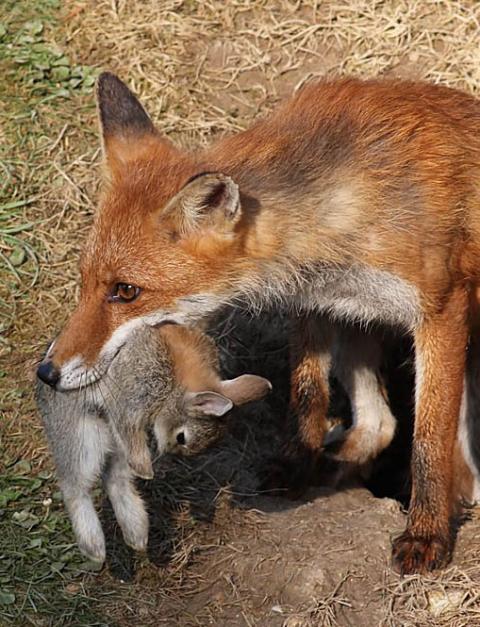
While the size of an animal's territory is largely determined by the distribution of resources across the area, group size is determined by the average abundance of those resources (i.e. how many animals the resources in the territory can support). Consequently, territory size and group size may vary independently and there is no significant relationship between the size of a territory and the number of animals living in it. This is because a small, but rich, territory can support more animals than a larger, but poorer, one. During some seasons or years there may be more resources in the territory than the residents require and this means that other individuals (usually offspring) may be permitted to hang around.
We will come back to this concept in the Behaviour and Sociality section when we look at how group living may have arisen in foxes, but in the meantime I mention it just as a sideline when discussing the flexibility that we see in the territorial system of the Red fox. Indeed, there is tremendous variation in both the territorial behaviour and territory size of foxes; from a complete absence of territoriality in some populations, to complete home range defence in others. Ergo, it is very difficult to come up with the size of an ‘average’ fox territory; if such a concept even exists. That which follows is an overview of territory sizes and “normal” home range movements of foxes—the subject of how far foxes move when dispersing is covered in a separate section (see Behaviour - Dispersal ).
It is now widely accepted that three main factors act in concert to determine the size and shape of the home range of a fox: food abundance; food dispersion; and location of shelters in relation to the main food patches. As a consequence, home range size varies widely: from about four hectares (ha)—almost 10 acres—in some urban areas, to 5,000 ha (50 sq-km or about 19 sq-mi) in desert regions, where resources are sparsely distributed. The largest territory of a UK fox that I have found so far is a dog fox in the Eriboll area of northern Scotland who ranged over 4,500 ha (45 sq-km or about 17 sq-mi). In his 1987 book, Running with the Fox , David Macdonald provides some examples of the huge variation in territory sizes:
Boar Hill (gardens and farmland) = 10-70 ha (averaging 40 ha) Oxford's mixed farmland = 100-250 ha Wytham Woods (private deciduous woodland) = 20-100 ha (ave. 60 ha) Oxford city = averaged 90 ha Suburban Bristol = 25-40 ha (increasing to 90 ha on council estates) Dutch heathland = averaged 880 ha Cumbria Fells = averaged more than 1,000 ha Oman desert = stable range of 5,000 ha Italian mountain meadows = 400-1,300 ha North America parks & mountains = typically 600-900 ha Barren cereal plains of North Dakota = up to 2,000 ha Arctic = 3,400 ha
So, were we to generalise, we can see that home ranges in Europe typically cover between about 40 ha and 1,300 ha (up to 13 sq-km or 5 sq-mi). This area may contain a single fox, a pair of foxes or, commonly in Europe, small family groups consisting of three to six related animals. Territories tend to be stable during the spring and summer, coming under increasing pressure during the autumn and winter as dispersal of cubs and long-range movements (in search of mates) increase; a difference less apparent among group-living foxes. Where foxes live singly, males seem to range over larger areas than females. In Edinburgh during the early 1980s, for example, Hugh Kolb found that average dog fox territories were 460 ha (just over 4.5 sq-km or almost 2 sq-mi), while vixens ranged over only about 150 ha (1.5 sq-km or just over half sq-mi). A study tracking foxes in the Netherlands found that males were significantly more territorially active than females. In contrast, however, a tracking study of foxes between May and September 1989 in central Kyushu in southern Japan found no significant differences between the territories of dogs and vixens.
Shoo or share? Territory exclusivity
The question of how exclusive territories are (i.e. whether all, part or none of them are actively defended) is deceptively complex and the tremendous flexibility in fox society means there is no “one size fits all” answer. In some cases, such as those encountered by David Macdonald while tracking foxes in urban Oxford, they never seem to trespass—in his Running with the Fox , Macdonald noted that neighbouring groups didn't trespass, even where some groups had food put out in feeding stations that the others must have been able to smell. Thus, it would seem that, if you have several foxes visiting your garden at once, they're likely to be members of the same social group.
Macdonald considered that habitat type was an important factor in determining territory exclusivity and, in his book, he described how territory boundaries may be “hazy” in rural (especially woodland) habitats, with neighbouring groups using the same clumps of trees and having paths that criss-cross. In urban areas, by contrast, streets provide clear demarcations of territories. He concluded that there was no trespassing in urban areas (where high-quality feeding sites were at stake, territory boundaries were sharply defined and meticulously observed), while deep in the woods (used mainly for sleeping by day) there was “ more latitude for neighbourly tolerance ”. This would certainly explain why, while tracking vixens in the Welsh mountains, Macdonald found that two neighbours occasionally used the same resting sites, although not at the same time. Studies on urban foxes elsewhere, however, paint a different picture.
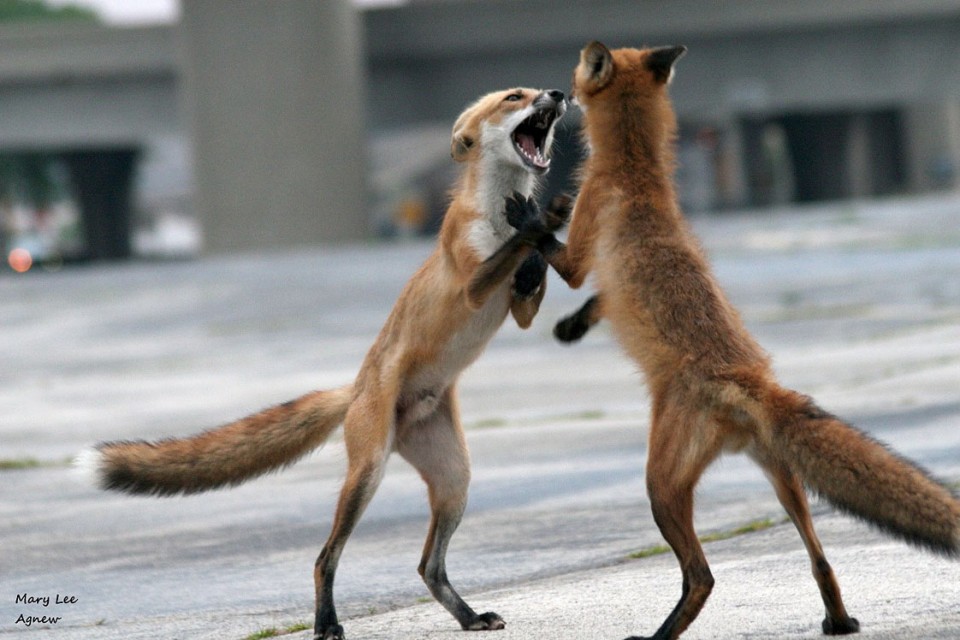
During 1978-79, for example, Stephen Harris tracked seven breeding vixens in Bristol, finding that they moved, on occasion, just over 300 metres (990 ft) outside their normal ranges and shared feeding sites with animals from adjacent groups. Harris concluded that, probably because the diverse pattern of food availability in urban areas is difficult to defend, the breeding vixens exhibited little, if any, territorial behaviour. Overall, the broad picture seems to be that foxes living in small ranges (at high densities) are more likely to maintain rigid territory boundaries than those living in larger ranges (at lower densities), although there is considerable variation between populations. Off-hand, it would seem logical that smaller areas are easier to defend than larger ones and this may be part of the explanation.
Influences on territory configuration
A territory can be large or small and may or may not be rigorously defended, but what determines its size and shape? We have seen that habitat plays a crucial role in terms of both landmarks to use as borders and the availability of food, but there is another important factor only recently alluded to: the size of the animal. In a 2008 paper to the Journal of Mammalogy , a team of Bristol University biologists led by Graziella Iossa described how: “ Increased body size in males appeared to confer an advantage in territory acquisition and defense ... ”. In essence, the biologists found that smaller males suffered more aggressive challenges for space (what the authors termed “boundary pressure”) than larger males and, as a consequence, tended to hold smaller territories. So, larger males held larger territories and made it more difficult for smaller males to secure space.
Earlier work on the take-over of fox territories conducted by Eric Preston in a large fenced enclosure in North Dakota during the summer of 1972, found that it was almost invariably the resident males that tackled intruders and, rather than expulsion being rapid and violent, it was: “... a rather gradual exclusion resulting from continual harassment by the resident male ”. Preston's findings are at odds with many of the observations that David Macdonald and Stephen Harris have made (both documenting rapid, violent expulsion of intruders—see Behaviour ), but it does give an indication of how the boundary pressure from larger males described by Iossa and her team might operate.
Given that territory size, shape and level of defence are dependent upon the availability and distribution of resources, it is not unexpected to find that foxes living in the food-rich habitat of the city tend to forage over smaller areas—about 50 ha (half a sq-km or one-quarter of a square-mile)—than their rural counterparts. There is, however, considerable variation in urban territory size and, in their 2010 overview of fox biology in Urban Carnivores , the Bristol University biologists give the following as territory sizes for urban foxes: 18-169 ha (Bristol); 54-93 ha (Oxford); 259 ha (Virginia, USA); 379-547 ha (Illinois, USA); and 420 ha (California, USA).
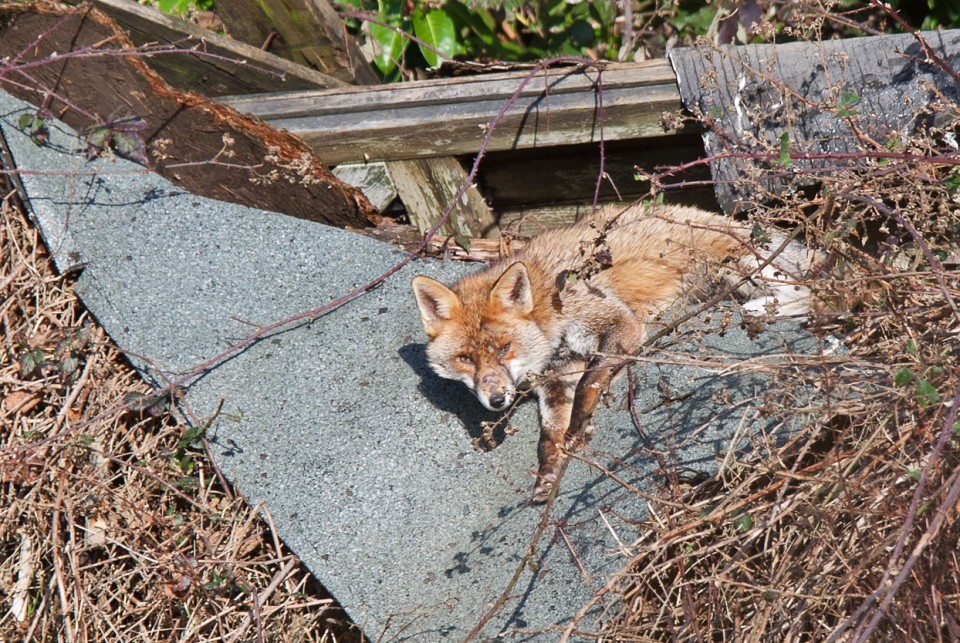
Urban territories are generally small with little or no overlap but, as Harris has alluded to above, there are areas (those with abundant food) where animals from neighbouring groups may come to feed without any apparent hostility. In some cases, where food is particularly abundant, so many foxes may be drawn in that it becomes impractical to defend the area and the only option is either to leave or tolerate the intruders. Another result of high food availability and small territories in urban areas is that fox densities tend to be higher; more foxes mean more competition for space and, in a highly tumultuous environment such as the city, where lots of vehicle activity means foxes generally live for less than two years, we sometimes see an interesting feature known as territorial drifting.
Radio-tracking studies of foxes in Oxford city by David Macdonald and Patrick Doncaster during the late 1980s and early 1990s demonstrated that territories were arranged in a “honeycomb” pattern and, although territories in the suburbs appeared spatially stable, the location of those in the city centre continually drifted. Moreover, the biologists discovered that the territories drifted in synchrony with each other (at a rate of about one territory per year) and, although the territories were reasonably small (averaging only 39 hectares—just under half sq-km or one-fifth sq-mi) they were constant in size. Thus, in Oxford city at least, it seems that as one part of the territory is yielded by fox “A”, this area is taken over by one of its neighbours (fox “B”); but fox B doesn't range over a larger area, rather it relinquishes a similar sized area of its own territory. Doncaster and Macdonald suggest that:
“ the ultimate explanation for drifting is that the city environment is inherently disturbed, by pedestrian and road traffic, habitat management and construction and demolition work .”
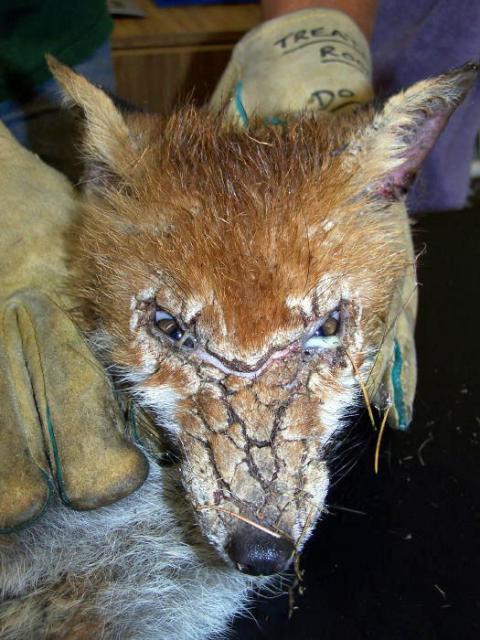
It is an interesting thought that such drifting may not be solely the result of foxes dying, but may also be affected by their changing landscape. Indeed, given that conspicuous linear features (e.g. roads, hedges, walls, etc.) are often used as territory boundaries, it is easy to see how the continual state of development in our major cities could lead to the continual fluctuation of fox territories. It seems that there may also be some seasonality to this drifting and, in his 1996 review of the Red fox social system, Paolo Cavallini noted that sudden home range shifts were more common during June to December, while drifting was faster in winter. The picture in Oxford, however, doesn't appear to be universal and, in the West Midlands, the exact opposite has been documented; with territories remaining stable for many years.
In Bristol, the arrival of sarcoptic mange offered an opportunity to see how the fox population responded to a drastic decline in numbers. Prior to the appearance of mange, territories of Bristol's urban foxes were found to be stable across years, with little overlap. In early 1994, a young male infected with mange arrived in Bristol, having spent the winter outside of the city; the disease spread rapidly through the population, causing the death of some 95% of the resident foxes. Unlike the foxes Macdonald and Doncaster tracked in Oxford, however, Bristol's foxes responded to the death of a neighbour by expanding their territory; essentially taking up the slack.
The biologists at Bristol University's Mammal Research Unit observed that, despite the increased level of food availability, foxes continued to expand their territories as neighbouring groups died; survivors took over this free space within a matter of days, enlarging their own territories until they came across an occupied territory. So, why would the foxes do this? They didn't need the extra food (after all, their own territories before the die-off supplied them with more than enough) and a larger area is more difficult to defend, requiring more energy to patrol. The Bristol biologists suggest that the foxes may have been attempting to prevent new animals from settling in the area by monopolizing space. In addition, in the pre-mange period, some foxes were observed splitting their territories—half being “given” to the resident's offspring—and if you hold a larger area, any future splitting is simpler and less costly in terms of resource loss.
So, fox territories may be very stable from year-to-year, they may drift as the habitat changes or they may expand as neighbours die. Additionally, some studies suggest that if a territory becomes vacant, and isn't amalgamated into a neighbour's range, the space is quickly filled by a new individual—studies by Andrew Wilson suggest that this happens within about a fortnight. How, then, do foxes stake out their territory? How does one territory holder know where their turf stops and their neighbour's starts? How do residents let passers-by know this spot is occupied?
The smell of home - scent marking territories
We have already seen that foxes often use linear landscape features such as hedges, tree-lines, roads and so forth as territory boundaries, but the territory owner still needs to let others know this is their hedge and what happens when there's no convenient feature? Given that permanent monitoring of territory borders isn't an option (foxes have much more pressing demands on their time), a convenient signpost is required in the owner's absence; for this foxes use scent to signify occupancy, leaving scent marks in the form of urine and scat at strategic sites throughout their territory. I don't plan to delve too deeply into this topic here (see QA in preparation ), but essentially foxes leave scent marks on travel routes in proportion to how frequently they're used and where in the social order the animal sits (dominant animals scent mark more than subordinates).
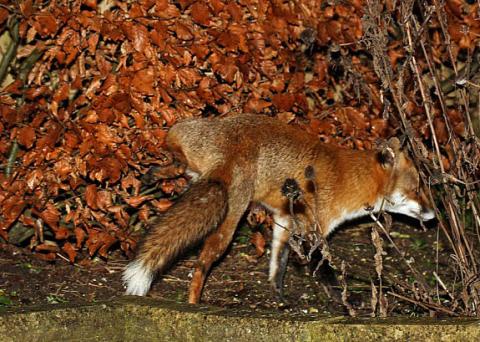
Droppings and urine are most commonly used as territory markers. An important feature of scent marking is that it should be obvious to others and this explains why most are associated with structural characteristics in the environment, such as landmarks. Indeed, droppings are almost invariably—about 80% of the time in some studies—left on visually conspicuous objects such as rocks, tufts of grass, garden gnomes, etc. Urine may be deposited on conspicuous objects, or squirted into vegetation at about nose-height. Droppings make more obvious and more robust signals than urine and so the two excretions may be used differently. Fox urine, scat and the secretions from various glands, including paired anal glands that can excrete on scats that the fox wants to use as territorial markers, contain hundreds of chemical aromas that convey a wealth of information about the individual who left it, as well as how long ago it was made. We know, based on work by Janosch Arnold for his Ph.D. at Bristol University, that fox scent marks contain information about the sex, season, relatedness, health and probably the social status of the animal who left it. It has also been suggested that resident foxes may recognise territory boundaries by the presence of “alien” urine.
Working with his captive vixen, David Macdonald found that the frequency of scent marking fell as you approached the border of her territory (where she would pause for a few seconds before spontaneously turning back). Macdonald described how the exact turning point could be changed by introducing a sample of alien fox urine near the border. If the alien urine was introduced just inside the boundary of her territory, she'd turn back when she smelled it (but would ignore her own transplanted urine), even if the area further on had previously been part of her territory. There was a limit, however, and if the alien sample was introduced elsewhere in her territory—i.e. not near the border—it was over-marked (urinated on top of) by the vixen. So, it seems that foxes scent mark most in the core of their territory—where they're most active—and less frequently at the periphery, with foxes having a fairly good idea where their territory ends based on where they expect to encounter foreign urine.
Scent isn't, of course, a permanent feature in the environment and after a while it gets degraded by rain, wind, etc. Consequently, the owner of the territory must revisit territory boundaries frequently to reapply the scent - at the same time, failing to do so will result in a weaker scent and might suggest to an intruding animal that the owner is either no longer around, or rarely visits this particular part of their range. Indeed, Macdonald, in a 1980 paper to the Symposia of the Zoological Society of London , suggested that the strategic placement of these scent marks may allow an intruder to chart a “safe” route through a territory by “reading” fresh urine marks; thus avoiding the resident. Indeed, data from field studies have shown that scent marks aren't deposited at random throughout the territory.
Between October 2005 and April 2006, Raquel Monclús at the Universidad Autónoma de Madrid and her colleagues looked at the scent-marking behaviour of foxes around rabbit warrens in central Spain and found significantly more fox faeces where the density of rabbits was higher. Foxes associated their scent marks to rabbit remains, paw scrapes and latrines significantly more than expected and more often than would be expected if at random. In their 2009 paper to the Journal of Ethology , Monclús and her co-workers suggest that foxes visit the rabbit warrens and scent-mark them more than other areas of the habitat and they can then use this high-density scent-marking to keep track of where the prey is within their territory and configure boundaries accordingly. Essentially, that the foxes were using the warrens as amplifiers for their scent marks. The researchers also observed that foxes marked more frequently in clearings than on roads. Clearings are considered strategic marking sites because they represent the intersection of multiple small tracks out of peripheral woodland.
Neighbour recognition?
Generally speaking, neighbouring territory holders have little to gain from fighting with each other (each territory has sufficient resources to support the animal and the potential costs of fighting can be huge) so once the initial battle has taken place to establish where the boundary should be, scent marking offers a conflict-free method of letting each other know that you're still around. Less time spent fighting also means that more energy can be devoted to finding food.
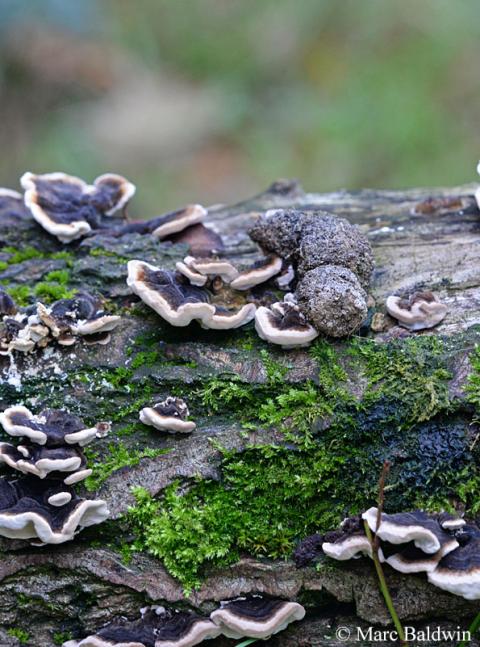
In a paper to the Canadian Journal of Zoology during 2011, Janosch Arnold, Carl Soulsbury and Stephen Harris report that foxes change their behaviour when unfamiliar urine is encountered in their territory. The researchers applied artificial fox urine to known fox territories to simulate the presence of an intruder and radio-tracked the residents to see what they did. The dog foxes didn't change the size of their territory, or the amount of time they spent active. They did, however, shift their daily activity range so they spent more time in the area where the fake scent had been applied; this was more pronounced in big males than smaller ones. The foxes searched a greater proportion of their territories on nights after the scent was applied than before the scent arrived—presumably looking for the intruder. Vixens showed no significant change in either their searching behaviour or activity range, suggesting that territorial defence is more male-centric.
Territory borders may be recognised by the presence of alien urine or, perhaps equally as probable, the presence of a familiar urine that the resident associates with a neighbour. In a recent note to BBC Wildlife Magazine , Stephen Harris noted how, when the foxes and badgers first appear in his garden in the summer, they sniff each other carefully and then ignore one another, but get very agitated when a stranger turns up. This, and many similar observations from other researchers, suggests that foxes are capable of recognising familiar and unfamiliar animals and that neighbouring territory holders may thus be able to recognise each other. Indeed, during the mid-1970s University of Washington psychologist David Barash trapped seven foxes and held them in cages so he could observe their reaction to each other. Barash found that foxes trapped near each other (within 8 km / 5.5 mi) showed dominance-submissive behaviour towards each other, while those trapped further apart showed more aggressive behaviour (threat gapes) to each other.
Despite the small sample size, Barash's data suggest that foxes can recognise their neighbours and that there may even be a rudimentary social structure between them. This is perhaps not surprising as, in urban areas at least, neighbouring groups are often related. Whether or not an intruding fox recognises the resident, several authors have described how invading individuals change their behaviour when they enter another fox's territory, moving more erratically and ceasing all scent marking. In 1972, the late-great zoologist Niko Tinbergen described how territory holding foxes on the sand dunes of the Ravenglass-Drigg Sanctuary in Cumberland knew their ranges very well and always used the same tracks (often in almost straight lines across open sand) from their earths to favoured hunting grounds; he sometimes found what amounted to “fox highways” along the shoreline. Newcomers to the area, Tinbergen noticed, acted quite differently:
“ A fox entering a strange hunting ground changed its behaviour: instead of running in a straight line across the open sands it would try to keep under cover and would move hesitatingly and follow an irregular route .”
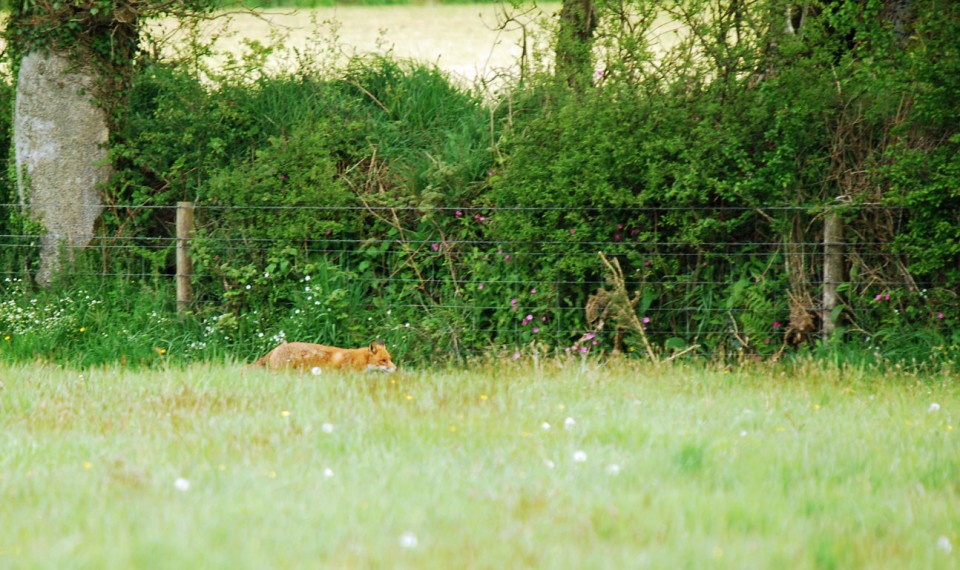
Interestingly, there are also observations of foxes urinating in such a way as to suggest they may be trying to cover up their scent.
Adele Brand in Surrey and Catherine North in Manchester captured well-grown fox cubs urinating in a water bowl on their trailcams during August 2018 and 2019, respectively. Similarly, West Sussex-based fox watcher Onyx Stewart tells me one of his adult vixens consistently did this in a tub of water in their garden, and Wildlife Online reader Tom Fitton has seen foxes do this during the summer in his garden in London. There was also a curious report of a fox approaching, and then urinating in, a cup of tea left on a kerbside in Wythenshawe while the owner worked on his car during December 2019. Along what I take to be similar lines, I have also received a description of “a nervous young fox” urinating into a drain in Hampshire a few years ago. The fox was seen from a flat window and the observer didn't investigate the drain afterwards, so cannot be certain the urine entered the drain rather than being deposited on the grate, although this was the opinion of the witness. More recently, in September 2023, Adam Taylor watched a vixen pull off a small drain cover and urinate into the drain in his London garden.
Given that foxes mark food remains and conspicuous objects within their territory, this behaviour may be interpreted as territorial marking intended for any other visiting foxes; drain covers, cups and water bowls are prominent objects within a territory, the latter likely to be visited particularly regularly during the summer when this behaviour appears most pronounced. Similarly, foxes meticulously keep track of their territory configuration and doubtless any new objects are marked to help the fox familiarise itself with them. The latter likely accounts for the urinating in the cup of tea. At this point, I cannot explain urination into a drain, particularly going to the trouble of removing the grate first.
Accepting the foregoing, however, if the urine mark is intended as a message, why dilute it? Granted foxes have a remarkable sense of smell, plus a well-developed vomeronasal organ, and are likely to detect the urine even in a bowl of water, but being mixed with the water must surely reduce its volatility and potency compared with, for example, urinating next to the bowl, which would presumably be detected by any other foxes visiting the resource. Furthermore, Tom Fitton tells me that other foxes (and badgers) drink from the bowl despite the contamination, without apparently over-marking as they would ground-based scent marks, perhaps suggesting the scent is much less perceptible. Recently, Kathryn Sobieski got in touch to describe how foxes visiting her property urinate and defaecate on the edges of food and water bowls, some of which inevitably enters the bowl itself, and this does not put foxes off using them. Similarly, one might assume urine ejected into a storm drain is less likely to be detectable to other passing foxes, although Dr Sobieski also referred to an Alsatian she used to have who urinated down drains in what she interpreted to be an innate reaction to cover up the smell of sewage.
It might be the case that foxes aren't aware that urinating into a water bowl or down a drain obscures their scent, but marking behaviour appears an innate behaviour (i.e., not one cubs learn from their parents) and yet “water-urination” seems comparatively rare, particularly among adults. Indeed, the observation that it tends to be subadult animals (i.e., those under a year old) exhibiting this behaviour during late summer raises the intriguing suggestion that it might be a way to “hide” or “dilute” their scent as they reach maturity on their parents' territory, or while trespassing looking for their own territory, thereby reducing the potential for conflict. I would be interested to hear from readers with experience of this behaviour, particularly by adults during the winter or spring.
Not only do foxes know what area their own territory covers and when they're trespassing in someone else's domain, there are some data suggesting they know where their territories are even if they're picked up and dumped somewhere else—in other words, that foxes have a homing ability. In Minnesota, USA, for example, wildlife biologists Robert Philips and David Mech found that a vixen they captured, translocated and released in November 1968 travelled the 56 km (35 miles) back to her original capture site within 12 days. Similarly, in his 1906 book Foxes at Home , Colonel J.S. Talbot told of a vixen and her cubs that returned to their earth “in due course”, having been trapped and relocated eight miles (13km) away. Quite how these vixens knew where their territories were remains a mystery, although it has been shown that European badgers ( Meles meles ) have a good idea where their territory is relative to those of their neighbours, and can use this knowledge to find their way home; foxes may retain the same information.
Seasonal variation in territory use
So we've seen how big a territory can be and how foxes mark it out, but how much of its territory does a fox use? This, like everything else we've tackled in this section, is not an easy question to answer either. There are many factors that influence how much of a territory gets used and how far a fox will travel each night, although the impact of season is perhaps most significant. The vast majority of tracking studies show the same trend: during the breeding season (winter) foxes travel further than they do at other times of the year. Indeed, during the breeding season males are known to move over large areas—regularly trespassing—as they search for receptive vixens, while females typically spend a greater proportion of the time at the periphery of their territories (again, this probably facilitates mate-finding).
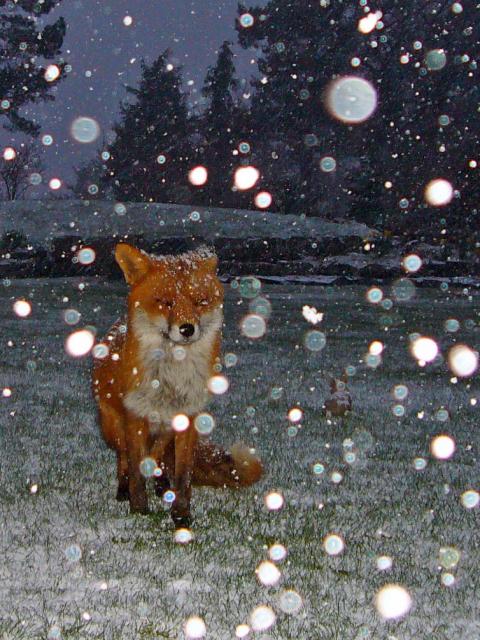
Studies in North America have found dogs increasing the length of their nightly movements by four to eight times come the breeding season. Similarly, tracking of Bristol's foxes has found that average winter ranges of males were more than twice the size of those in spring, summer and autumn (although caution should be used owing to low sample size) as they trespassed into neighbouring ranges in search of receptive females with which to mate—there was no significant difference in the seasonal range of females. Interestingly, although no seasonal difference was found for females in Bristol, this may indicate that none became pregnant during the study. Several studies have demonstrated how pregnant foxes move shorter distances around the time they give birth and for several days after the cubs are born.
Working with the foxes of the Ashio Mountains in Central Japan, for example, Masahiko Takeuchi and Masaaki Koganezawa found that their pregnant vixen's range had decreased by six-fold by the time her cubs were about to be born (pre-breeding range was 601 ha, declining with the advance of her pregnancy to 109 ha by the time her cubs were born).
Seasonal variations in ranging may, however, be for reasons more subtle than searching for a mate or the birth of cubs. Studies in Europe have shown that, during the late summer and autumn, foxes feed heavily on fruits that are locally clumped (they can strip a bramble bush of blackberries in no time); the result is that they need to move around less than they do during the summer or winter (when finding food for cubs and when food is more difficult to find, respectively).
Between 1992 and 1994, Hideharu Tsukada at Hokkaido University studied the interaction and territorial behaviour of 42 foxes in Japan's Shiretoko National Park. In his 1997 paper to the Journal of Ethology , he described a flexible territorial system associated with the distribution of food. When food was not concentrated, resident foxes were highly territorial, showing exclusive distribution of home ranges between families and defence against other foxes at the boundaries. When food was concentrated, such as during the salmon spawning period or when tourists were feeding foxes in the park, home ranges overlapped and foxes made round trips of up to 8km (5 miles), lasting up to three days, from their territories to take advantage of the localised concentration of food.
Interestingly, when one male fox died, his territory was absorbed by neighbouring animals after about eight days. This perhaps explains why Tsukada observed that most foxes making trips away from their range to use seasonally concentrated food sources were away for only a day on average; three days maximum. Food sites more than 8km away weren't utilised and, in the paper, Tsukada suggests:
“ This suggests that available feeding sites for foxes were within the area that foxes could reach in a day. This suggested that localized food in other families' home ranges could be utilized by foxes without a high risk of losing their territories .”
These paws are made for walking
Generally speaking, foxes move roughly the same distance each night, although adverse weather conditions (especially snow cover) may reduce the distance travelled. In Bristol, foxes moved an average of eight kilometres (5 mi.) per night, rarely exceeding 10 km (6 mi.). Similar values have been recorded in Japan (6-8 km) and Spain (4-5.5 km / up to 4 mi.), with slightly longer trips (up to 15 km / 9 mi.) in more remote European and North American environments.
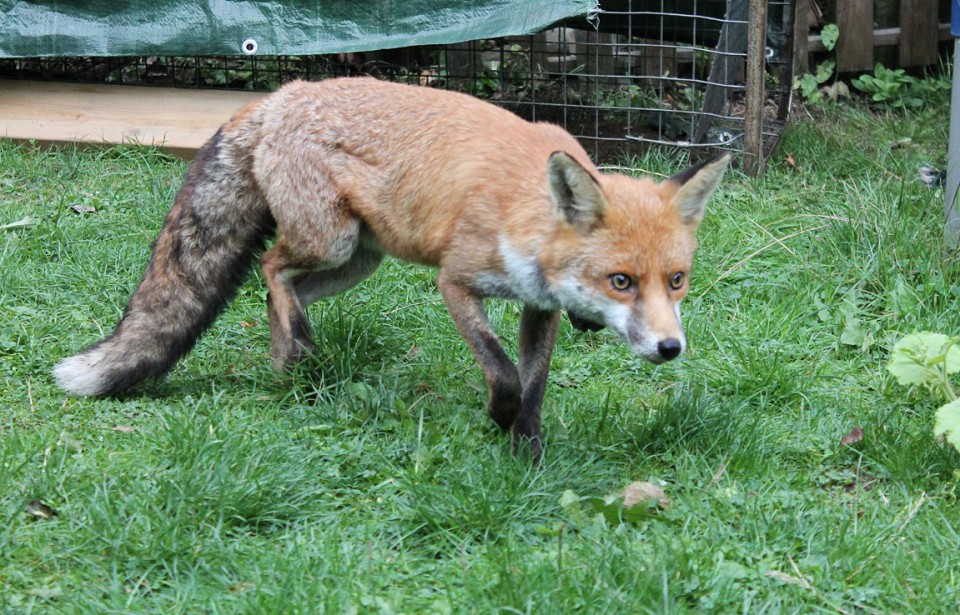
In the UK, the longest distance travelled by a fox that I have come across in the literature was a male that was tagged as a cub by Huw Lloyd at an earth in mid-Wales and was later shot by a gamekeeper 52 km (32 miles) to the north-east. More recently, however, Brighton University's Dawn Scott tagged an adult male fox in suburban Brighton that was tracked a staggering 315 km (195 miles) from Brighton to Rye in East Sussex in just under one month. This particular fox, known to BBC Winterwatch viewers as Fleet, was believed to have been ousted from his territory by his son (possibly as a result of his suspected lungworm infection); he left Brighton on 9th December 2013 and in two days had reached the rural setting of Ditchling Beacon on the South Downs, some 7 km (just over 4 miles) away.
Fleet spent a couple of days on the South Downs Way before heading north-east, through various towns and villages and, by 18th December, he had travelled some 200 km (124 miles) from his previous territory. He moved south briefly, towards the A27, and then back north to spend Christmas Eve and Christmas Day at a caravan park near Uckfield, where he was presumably fed by, or scavenging food from, residents. The track continued to just north of Westfield in East Sussex, where the signal was lost during early January 2014; a total distance of 315 km (196 miles) and by far the longest verified dispersal by a single fox in Britain. Moreover, Fleet's impressive ramble tops the 203 km (126 miles) by a vixen in North Dakota, of the longest dispersal distance recorded by Stephen Allen and Alan Sargeant, and is not far off that of a dog fox tagged in Wisconsin and recaptured nine months later 394 km (246 miles) in Indiana. It should be noted that, despite a fairly extensive search of the area where the final signal was received, there was no sign of Fleet's body, suggesting that the collar may have failed, and Fleet's journey may still be in progress. It may also be that there was some human interference (e.g., someone shot the fox and move the carcass), but there was nothing about the track of the GPS to suggest this.
More recently, between 2011 and 2017, Zea Walton and her colleagues at Inland Norway University of Applied Sciences tagged 101 foxes of both sexes within four areas of Norway and Sweden with GPS transmitters. Their data, published in the European Journal of Wildlife Management in 2018, show that cumulative dispersal distances ranged from 132 to 1,036 km (82-644 miles), with straight line distances of between 67 and 294 km (42-183 miles) during dispersal events ranging from seven to 22 days. Two foxes subsequently doubled back to settle in an area they had previously explored. Interestingly, while these tracking data highlight the mobility and dispersal capability of foxes across large scales, genetic analysis on the same population by Walton and her co-workers also revealed low levels of genetic differentiation, implying that relatedness plays a strong role in the spatial organisation on a local scale. This was particularly so for females, the researchers finding male-biased dispersal in this population.
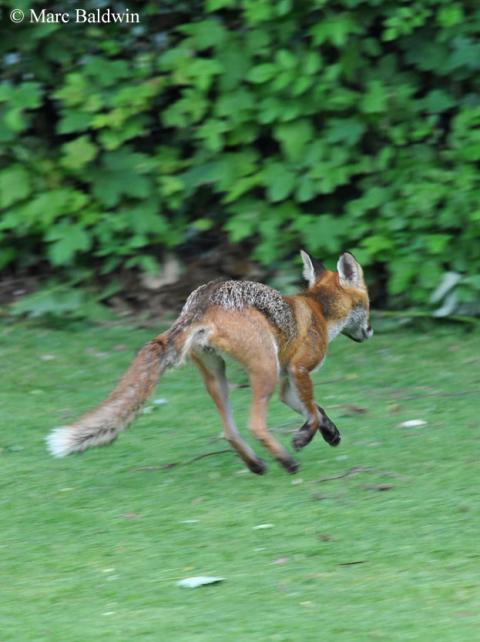
Foxes may temporarily leave their territory if there are highly concentrated food resources nearby. Foxes in Japan's Shiretoko National Park, for example, were observed to leave their territories for up to three days while they foraged on concentrated food sources (salmon carcasses and human food) elsewhere in the park, although they didn't stray more than eight kilometres outside of their range. Overall, it seems that foxes focus most of their time at specific parts of their range (generally feeding and resting spots), so they may move several kilometres, but stay in a relatively small area, often using only part of their range.
Nightly patrols or flying visits?
When foxes do move around during their nightly activities they do so along a series of well-defined paths that are about 30 cm (12 in.) in diameter and on which the grass has a “trodden down” appearance. Commonly foxes will use the same paths on successive nights if they lead to a favoured hunting spot, although my experience is that they are less predictable in their habits than badgers. Foxes often opt for the path of least resistance while commuting, using field margins, badger or deer runs, or the “tramlines” of vehicles that have driven across the field.
It is sometimes assumed that, as part of its nightly wanders, a fox will travel in a circuit around the territory, essentially patrolling the borders. In some cases (where territories are small and the fox density is high) this invariably does happen, but many studies have found that foxes focus the majority of their activity in a core area (a breeding earth or rich hunting ground, for example). Studies both here and in the USA have found that, in most cases, foxes don't visit their territory borders every night; in a large territory the fox may only visit a border area once every few days, although the movements of adult members of a group appear to collectively result in visits to all borders every week-or-two.
Even in small ranges, the fox invariably doesn't use the entire range every night. Indeed, in 2002, Polish biologist Jacek Goszczyñski reviewed the published data on fox home range and found that foxes living in small ranges (up to 150 ha) used 36-70% of the range daily, while those living on larger ranges travelled over similar sized areas but that these represented a much smaller proportion of the seasonal range (only 16% of the largest home range included in the analysis was used on any single day). So, the foxes moved over roughly the same sized area each night, regardless of how large their territory was, even if that meant some areas were almost never visited.
Non-territorial foxes
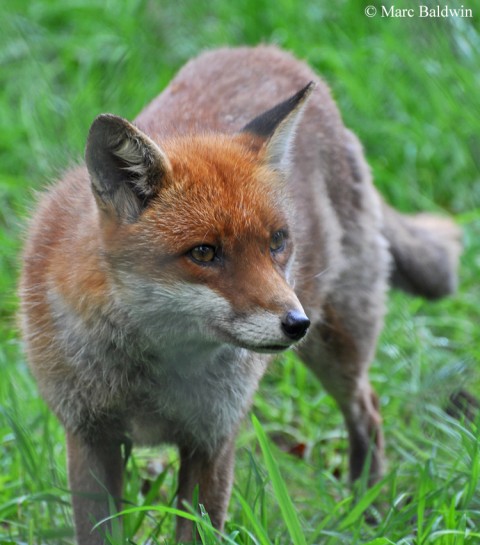
It should be noted that, although territoriality is well known in Red foxes throughout most of their range, it is not observed in every population. Between January 1989 and April 1992 (with an intermission during the Gulf War), a team of biologists from Oxford's Wildlife Conservation Research Unit led by David Macdonald conducted a detailed study on the Red foxes of the biological reserve of Thumamah in the great sand deserts of Saudi Arabia ( Vulpes vulpes arabica ).
Over a period of three years, 41 foxes (21 males and 20 females) were fitted with radio collars and their movements tracked, revealing an average home range of 676 ha (almost 7 sq-km or just over 2.5 sq-mi) that didn't vary according to sex or season. The most interesting discovery was the lack of territoriality; instead they observed loose-knit groupings, with females sharing territory more readily than males. The biologists suggested that this situation arose because it helped the foxes, which are smaller than Red foxes found in Europe (i.e. about half the size of those in the UK), survive in an extremely harsh environment with a spatially and temporally sparse food supply.
Finally, it is worth mentioning that, even where territoriality is commonplace, not all foxes partake. Indeed, it is estimated that some 15% of adult Red foxes wander with no fixed home range; these animals are called itinerants. Little is known about the behaviour of itinerant foxes, although studies by Andrew Wilson during the mid-1990s suggest that these animals behave differently to territory holders in their habitat use.
In his bio of the Red fox in the RSPCA's 1981 British Mammals book, David Macdonald notes that itinerants are usually males and may move in a straight line or weave a meandering course through the countryside, ranging up to 250 km (170 mi.); he gave average ranges of 20–50 km (13.5–34 mi.) for males and 7-15 km (5–11.5 mi.) for females. Macdonald does point out that the distinction between itinerants and residents is blurred, with some territory holders commuting long distances between centres of activity. Indeed, in a contribution to a 1980 special edition of the journal Biogeographica on Red fox ecology, Huw Gwyn Lloyd noted that, although it's often perceived that foxes are either sedentary or itinerant, in reality an individual can be intermittently itinerant; in mid-Wales he tracked a dog fox making frequent excursions out of his territory (up to 16 km away), but always returning to his familiar range sooner or later.
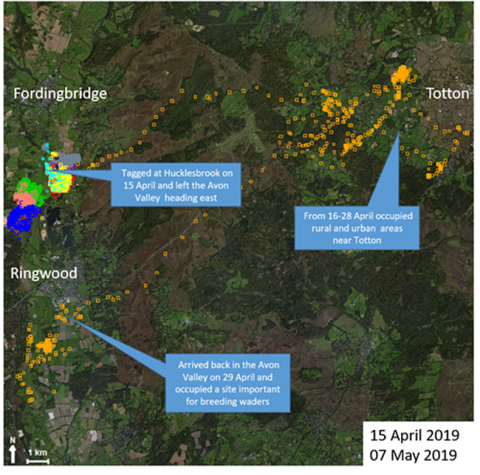
In mid-April 2019 a non-breeding vixen, nicknamed “6644” by the Game & Wildlife Conservation Trust biologist who had fitted her with a GPS collar, was released after having been caught in a snare in a river meadow at Hucklesbrook in Hampshire's Avon Valley. After resting up in a hedge for a few hours she began a purposeful journey eastward across the New Forest, navigating along streams and forestry tracks, to settle 25km (16 miles) away in a rural area near Totton the following day. There she remained for a couple of weeks, moving within about a 4km (2.5 mile) radius. On 28th April, 6644 upped-sticks and took a more or less straight line south-west back to the Avon Valley, arriving on a nature reserve near Ringwood the following day. She moved widely around Ringwood before she was shot by a gamekeeper in early May. The GWCT's GPS data illustrate how some foxes move widely and nomadically, such animals easily covering distances of 20km (12 miles) in a single night.
It has also been established that if a juvenile fails to establish a territory, its activity area becomes smaller and it becomes what German biologist Ad Vos called a “floater” (local itinerant) in a 2003 paper to the Journal of Veterinary Medicine ; these animals generally occupy border zones between neighbouring territories.
- Rabies and the Red Fox
- Deterring Foxes
- Fox Hunting & The Hunting Act (2004)
- Mange in the Red Fox
- Abundance & Population
- Ageing & Longevity
- Appearance, Coat Composition & Insulation
- Behaviour - An Introduction
- Behaviour - Body Language
- Behaviour - Communication
- Behaviour - Dispersal
- Behaviour - Evolution of Group Living
- Behaviour - Helpers in Fox Society
- Behaviour - Nightly Interactions
- Behaviour - The Social Hierarchy
- Coat Colour
- Dens/Earths & Resting Sites
- Distribution
- Evolution & Early Distribution
- Food & Feeding - An Overview
- Food & Feeding - How Much Food?
- Food & Feeding - Hunting Strategies & Behaviour
- Food & Feeding - Influence of Age & Sex
- Food & Feeding - Killing to Excess & Storage of Leftovers
- Food & Feeding - Pets & Livestock
- Food & Feeding - Prey Switching
- Food & Feeding - Scavenging
- Food & Feeding - What Foxes Eat
- Interaction with Humans - An Introduction
- Interaction with Humans - Feeding Wild Foxes
- Interaction with Humans - Fox Domestication
- Interaction with Humans - Fox gods, devils and worship
- Interaction with Humans - Foxes as Allies
- Interaction with Humans - Fur, Meat & Sport
- Interaction with Humans - Pests & Pest Control
- Interaction with Humans - The Emblematic Fox
- Interaction with Humans - The Fox in Literature & Film
- Mortality & Disability
- Parasites & Diseases
- Reproduction - An Introduction
- Reproduction - Gestation, Birth & Litter Size
- Reproduction - Growth & Development of Cubs
- Reproduction - Mating & Monogamy
- Reproduction - Number of Breeding Vixens
- Reproduction - Reproductive Development
- Reproduction - Schooling the cubs
- Size & Weight
- Species Interaction - An Introduction
- Species Interaction - Australia's Native Wildlife
- Species Interaction - Deer
- Species Interaction - Gamebirds & Waders
- Species Interaction - Livestock
- Species Interaction - Other Carnivores
- Species Interaction - Plants & Invertebrates
- Species Interaction - Small & Medium-sized Mammals
- Territory & Home Range

PlanetJune by June Gilbank: Blog
Planetjune craft blog, red fox and arctic fox patterns.
September 3, 2009 @ 9:45 pm · Filed under Crochet , Patterns
Remember my Red Fox from last week? I decided to make him a cousin in a white brushed yarn, to be an Arctic Fox, and now I’ve completed both patterns. Two different foxes with very different appearances – which is your favourite?
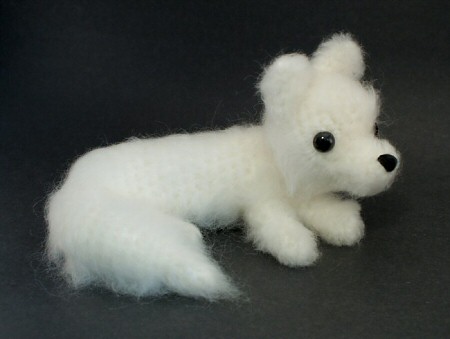
Arctic Fox is a great project to try if you’re intrigued by the idea of brushed crochet. Brushing the finished crocheted pieces gives a realistic fur effect, and because it’s all done in one colour, that’s one less thing to worry about 🙂 Full instructions are given in the pattern – all you need is a wire pet brush or a mohair brush, and you’re guaranteed to get a cute fluffy result! And the pattern also works with regular yarn, if you don’t want to try the brushing technique.
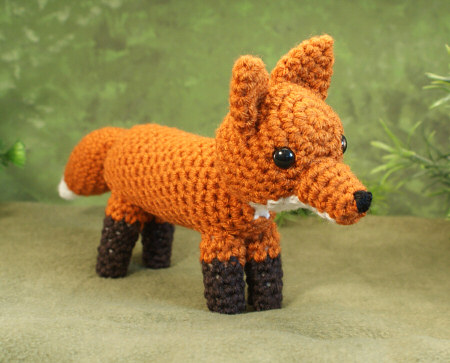
Red Fox has a totally different appeal, combining 3 colours with that distinctive shape to make a realistic amigurumi fox with a cunning glint in his eye!
It’s amazing that you can achieve such different effects with just a crochet hook, some yarn and the single crochet stitch! I really do love crochet…
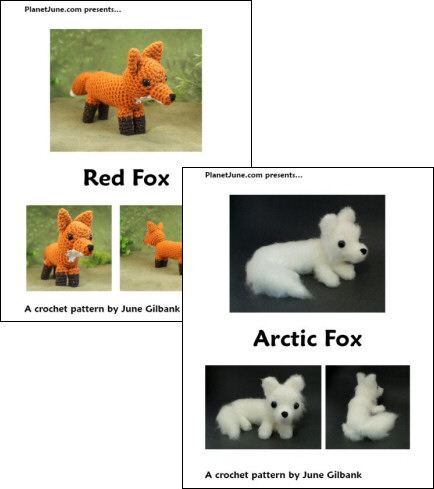
The patterns are for sale in the shop for $4.50 each. If you’d like to try both types of fox, I’ve made a fox multipack including both patterns for only $7.
Happy crocheting!
10 Comments »
Well, after studying both of them long and hard, I have concluded that I can’t pick a favorite, lol! They are both so cute in their own way. The red one looks more sly and cunning, while the white one looks adventurous and sweet. Soooo, it’s a tie in my book.
Thanks for giving us instructions on brushing the yarn. I knew about brushing the yarn, but I always thought you had to use wool for it to look right so I’ve never even tried it. Although I remember reading in another post of yours that you’re allergic to wool, yet I’ve seen other ‘fuzzy’ ami creations of yours, so I should have put 2 and 2 together. Now I’ve got to try it!
Great job as always, June!
chanel said
I LOVE the arctic fox.
Thank you all!
Jana, I just measured and my super-sized Arctic Fox is about 10″ nose to bum – he’d be about 18″ nose to tail if posed like the Red Fox. The hook, yarn and eye sizes I used are included in the pattern if you want to make an exact duplicate, but Patons Divine is fuzzy to begin with and so isn’t as easy to crochet with as regular yarns. If you’re going to brush it anyway there’s no point in making your life unneccessarily difficult!
You could use a bulky weight yarn and an approx 4.5mm hook to get a similarly super-sized fox – and that advice also applies to all my ww patterns if you want to make them bigger.
WOW! You want me to pick a FAVORITE? Impossible! They are BOTH adorable! How big WAS the Arctic Fox? I kind of like the idea of a bigger one!
Melissa Jenkins said
Oh my goodness how brilliant. ^^ Who would have known that scratchy wool yarn could look so fluffy if you brushed it? I would LOVE to make some of these animals some day! Oooooh I might go pick up some yarn this weekend. 🙂 I just love this idea.
I looooove the foxes!! They’re so cute and realistic! Thanks for posting them and the pattern! 🙂 I love them 🙂
Thank you, Erin! Craft Passion, thank you so much for the award 😀
Melissa, I did an experiment on which yarns work well for brushed crochet. Turns out, although natural fibres e.g. wool and mohair, give more realistic fluff, and more of it, you can have success with pretty much any yarn! You can see my full blog post here: www.planetjune.com/blog/brushed-crochet-experiments/
If you’re not allergic to wool (I am, so I couldn’t do this myself!) I’d recommend a yarn with a high percentage of wool – I’m sure WalMart would sell Lion Brand Wool-Ease or something similar. Otherwise, as my experiment showed, you CAN successfully brush 100% acrylic yarn, although it will look a bit less realistic. (See the pic of the grey ball in my blog post linked above.)
(FYI, I used Patons Divine yarn because I wanted a mohair/wool yarn and it’s the only one my hands can tolerate. It’s a lot bulkier than the worsted weight I recommend for the pattern, so I had to use a larger hook and massive 15mm eyes – I ended up with a giant fox! Use worsted weight yarn instead – much easier!)
Craft Passion said
Ohhhh…. the foxes look so adorable and cute!!! I wish that I could hug them 🙂
I have nominated an award to you, please come to my blog and claim it 🙂
Btw, I will become your fan in facebook 🙂 Your works are truly awesome !!!!
Erin @ Living and Loving In L.A. said
These little guys are so cute! Great job. I love them!
I LOVE the arctic fox. I had never thought of brushing the yarn! What an awesome idea. What kind of yarn is used for the arctic fox…or what kind would you recommend? I only have access to local stores like Walmart for yarn, so I’m wondering if a bernat soft yarn would work.
RSS feed for comments on this post
Leave a Reply Cancel reply
Thank you so much for taking the time to leave a comment here! I read and appreciate every comment. I only respond to questions here on the blog , so please return to this page to see my reply, or check the box below to subscribe to new comments by email.
Please note that I can only answer questions related to PlanetJune patterns and tutorials ( see details ), and I can only respond to questions or comments written in English. Thank you :) - June
Notify me of new posts by email.
Current ye ignore me @r *
Leave this field empty
Quick Links: Crochet

Quick Links: Crafts

Blog Post Categories
Blog archives.
Browse posts by date
- February 2024
- January 2024
- December 2023
- November 2023
- October 2023
- September 2023
- August 2023
- February 2023
- January 2023
- December 2022
- November 2022
- October 2022
- September 2022
- August 2022
- February 2022
- January 2022
- November 2021
- October 2021
- September 2021
- August 2021
- February 2021
- January 2021
- December 2020
- November 2020
- October 2020
- September 2020
- August 2020
- February 2020
- January 2020
- December 2019
- November 2019
- October 2019
- September 2019
- August 2019
- February 2019
- January 2019
- December 2018
- November 2018
- October 2018
- September 2018
- August 2018
- February 2018
- January 2018
- December 2017
- November 2017
- October 2017
- September 2017
- August 2017
- February 2017
- January 2017
- December 2016
- November 2016
- October 2016
- September 2016
- August 2016
- February 2016
- January 2016
- December 2015
- November 2015
- October 2015
- September 2015
- August 2015
- February 2015
- January 2015
- December 2014
- November 2014
- October 2014
- September 2014
- August 2014
- February 2014
- January 2014
- December 2013
- November 2013
- October 2013
- September 2013
- August 2013
- February 2013
- January 2013
- December 2012
- November 2012
- October 2012
- September 2012
- August 2012
- February 2012
- January 2012
- December 2011
- November 2011
- October 2011
- September 2011
- August 2011
- February 2011
- January 2011
- December 2010
- November 2010
- October 2010
- September 2010
- August 2010
- February 2010
- January 2010
- December 2009
- November 2009
- October 2009
- September 2009
- August 2009
- February 2009
- January 2009
- December 2008
- November 2008
- October 2008
- September 2008
- August 2008
- February 2008
- January 2008
- December 2007
- November 2007
- October 2007
- September 2007
- August 2007
- February 2007
- January 2007
- December 2006
- November 2006
- October 2006
- September 2006
- August 2006
- Search Search
Welcome to PlanetJune!

Support PlanetJune!
Want to say thanks? You can send me money in seconds at paypal.me/planetjune (over $20) or paypal.me/planetjune2 (under $20) or send me a donation through my shop .
Or simply click through from my links before you shop at Amazon, Etsy, KnitPicks, LoveCrafts or Crochet.com, and I'll make a small commission on your purchase, at no cost to you! Start here:
♥ Support PlanetJune ♥
Tip: This link is also in the footer of every page!
Thank you so much for your support!
All content copyright © 2006 - 2024 June Gilbank
- Video Library
- Monthly Collection
- Craft Academy
- Paper Flowers
- Felt & Fiber
- Kid's Crafts
DIY Felt Woodland Red Fox

- Copy Link
Join our email list to learn about new projects, discounts, and membership perks!
If you couldn’t tell, we love foxes ! We have made a few different felt foxes over the years, but this felt red fox is our first standing version. And it fits in perfectly with all of the other woodland animal stuffies that Krista has designed.
Due to its construction, this is a great intermediate felt project. So if you’re looking for more of a beginner project, you may want to try this felt fox stuffie instead.

Goodies You Can't Google
You've found a member-exclusive project. But for less than the price of a fancy coffee... You'll get instant access to this and over 2,000 other premium projects inside the Lia Griffith membership!

Think outside the fox
We love helping you get creative! Our felt red fox would make a great handmade gift for kids — or anyone who loves foxes. If you are making this at home with little ones around, they can join in on the fun by crafting our pom-pom fox pals , this simple felt fox cup cozy , or a felt pinecone fox .
Crafting tip: For a more wintery version of this felt red fox, you could use white or gray felt instead to make an arctic fox.
New to crafting felt animal stuffies and want to learn more? Take our mini course, 8 Easy Steps to Create Any Felt Stuffie .
This content uses links from which we may earn a commission. Disclosure .
How to Make a Felt Red Fox
- Gather your craft tools and materials. Then download the fox pattern on the right hand side at the top of this post.
- Cut out felt according to pattern using a Cricut Maker (optional) or scissors.
- Sew the legs to the underside piece using two strands of white embroidery floss and a whip stitch, working from what will be the inside of the legs. Match and follow the curve of the leg openings, and ensure that the legs are facing the right way.
- Repeat this step for all of the legs.
Full tutorial available for members to download on the right hand side at the top of this post.

Explore More
If you love foxes like I do, make sure to check out all of our fox crafts , including this beautiful fox artwork . You can also make some other woodland animals to go with your felt fox, like our felt moose , wolf , and bear .
For more DIY inspiration, join us on Facebook , Instagram , Pinterest , and YouTube .
Tools
- Cricut Maker or Silhouette Cameo 4 (optional)
- Detail Scissors (recommended)
- Craft Scissors
- Embroidery Needle
- Straight Pins
- Stuffing Tool
Materials
- Lia Griffith’s Wool Blend Felt — Oakwood , Bark Brown , Cotton , and Black
- Embroidery Floss — DMC Dark Red Copper (918) , Ultra Dark Coffee Brown (938) , Ultra Very Light Mocha Brown (3866) , and Black (310)
- Black Craft Eyes — 5mm
- Polyester Fiber Fill — Lia Griffith Stuffie Puff
- Fabric Pen — Dritz Disappearing Ink
All the Goodies You Can't Google 🎁
Tired of scrolling endlessly for the perfect project? Save time, money, and Google-induced headaches with us! Our membership makes it easy to create beautifully finished crafts without needing to look all over the internet for ideas and materials or spend lots of money on individual videos and templates.
Already a member? Click here to log in.
Ask Lia or the community!
Leave a comment cancel reply.
Your email address will not be published. Required fields are marked *
Save my name and email in this browser for the next time I comment.
13 Comments
The felt in the picture looks red, but the Oakwood felt looks very much brown through my computer screen. Is the Oakwood felt specifically what was used in the pictured fox? Thanks so much!
It is. The photos may be a bit off. I try to keep an eye on that when I photograph, but sometimes, the light just throws things off a bit.
Do you have to pay to join to download the felt patterns?
Yes, we are a membership site that offers these gorgeous projects for a super low cost.
Are your felt animals sewn by hand or machine? You have the cutest animals and I would like to try them. I know I have to become a member. Thanks!
Hi Teresa! They are all sewn by hand! We hope you become a member and try them out 🙂
Hi again. Thank you for providing the size. These animals are for a mobile and I noticed on another page you spoke about downsizing them. Am I right in thinking that you could do this through print settings and changing 100% to whichever smaller percentage you needed e.g 70%. Would everything be scaled so the animal still looked correct? Thank you!
Yes, you can print at a lower percentage to downsize and everything should all fit together for each project. Your project sounds adorable!
Hello. How tall and wide is this once made? How do you find the size of the other woodland stuffies?
He is about 4-5 inches tall depending on where you are measuring. You can look at the PDF file and measure height there, knowing you will lose a little with the sewing.
Hello Lia can I please ask is this pattern made by delilahIris as I bought an identical pattern there a few years ago and its identical 🙂 does she designs the patterns for you 🙂
No, it’s not. We design all of our own patterns. When it comes to creating animal stuffies, there are going to be some similarities in the construction because we are designing them based on real animals and want them to look as realistic as possible; however if you look closely, the pattern is not identical. We used our wolf pattern (which you can find here: https://liagriffith.com/felt-wolf/ ) to create this fox and made tweaks to make it look more like a fox.

Member Login
Email Address
Remember Me
Let your creativity bloom!

Join our email list to get a free flower crafting project bundle . Create four pretty peonies with the materials you already have on hand - in 60 minutes or less.
Your fresh picked peony projects are on the way to your inbox!
Continue Download?
This will use up one of your extra projects for the month.
Save posts to your craft room with the Lia Griffith membership.
Enjoy your freebie.
Join our email list to instantly download this freebie and get more DIY inspiration delivered to your inbox.
- Email Address *
- Hidden download_url
Already a member? Log in to get this freebie.
You are using an outdated browser. Please upgrade your browser to improve your experience.
How to Tie Dave Whitlock’s Red Fox Squirrel Nymph
Producer: tightlinevideo
The fly fishing and fly tying community recently lost one of the greats, Dave Whitlock. He was a remarkable angler, an exceptionally talented artist and author, and, based on my brief conversations with him, an incredibly kind and compassionate human being. He will be sorely missed.
This is the Red Fox Squirrel Nymph, one of his more well-known patterns. It’s elegant, versatile, effective and rather easy to tie. In other words, a near perfect fly.
The Red Fox Squirrel Nymph starts with a 2X long nymph hook, here a Fulling Mill 5085 in size 14. Begin by getting the hook firmly secured in the jaws of your tying vise.
.015 lead-free round wire is used to add some weight to the fly and some taper to its body. With the spool in your left hand, place the bitter end on top of the hook shank and take thread wraps to secure it. Pass the spool to your right hand and begin making touching rearward wraps with the wire behind your tying thread. After 10 or so turns, anchor the wire with tight wraps of tying thread as you pull it in line with the hook shank. Rock the wire up and down while you make thread wraps. This will break it off close, leaving a short ramp down to the hook shank. End with your tying thread just back from the hook point.
Small, oval gold tinsel is used to rib and segment the fly, as well as give the illusion of transparency. A 6” length is enough to make several Red Fox Squirrel Nymphs. Lay one end against the far side of the hook and take thread wraps to secure it there. It’s placed on the far side so as not to jostle the tail during its first wrap.
The tail of the fly comes from a natural fox squirrel skin. You really want the fur from the center of the back. Grab a small pinch and snip it free, down close to the skin. The coloration is just plain awesome. Strip out the underfur and the shorter hairs from the butt ends, then remove any overly long guard hairs. This is a little too much so I’m going to remove a few more hairs. That looks about right. Measure to form a half-a-hook-shank length tail, that’s really more like an extension of the fly’s abdomen.
Transfer that measurement rearward to the start of the bend, then reach in with your tying scissors and snip the excess butt ends off square. Give your bobbin a counterclockwise spin, as if you’re looking down on it, so the first wrap will jump slightly rearward to catch the butt ends. Keep making rearward thread wraps to anchor the hair to the top of the hook shank, all the way back to the start of the bend. Then return your thread forward to the back edge of the wire wraps.
For the abdomen, I’m going to use Mr. Whitlock’s custom SLF blend, called Red Fox Squirrel Abdomen. Pull an ample clump free from the packet or dispenser, then use it to create a slender 2 1/2 inch-long noodle on your tying thread. Start taking wraps with the noodle so the dubbing begins right at the base of the tail. Continue taking touching wraps forward to build up a lightly tapered abdomen that extends nearly 2/3 of the way up the hook shank, about like this.
You can then get hold of the tinsel, and start making open spiral wraps with it over top of the dubbed abdomen. Notice how the first wrap didn’t jostle the tail in the least. After 5 or 6 turns, use your tying thread to anchor the tinsel then snip the excess off close.
Another one of Dave’s custom dubbing blends is used for the thorax of the fly. It’s a very different texture than that used for the abdomen, as well as being a darker color. Here, create a much shorter noodle on your tying thread, that’s about 1 1/2 inches in length. Start taking wraps with the noodle to build up an ample little thorax in front of the abdomen, making sure to leave some space behind the hook eye. If needed, take a few rearward thread wraps to hold the dubbing back and out of the way.
To represent legs and the like, I’m going to use a soft hackle hen saddle patch in speckled brown. After plucking one of the smaller feathers free from the skin, I’ll strip off all the lower fluffy stuff from both sides of the stem. You want the hackle to be very, very sparse so keep stripping until you’re left with just the very tip of the feather. You can use your fingertips to get a hold of this, but I prefer to use angled tweezers to firmly grab just the feather’s tip. You can then sweep the lower fibers down and snip just the very tip off, leaving a small, triangle-shaped tie-in anchor. Lay the anchor against the near side of the hook, give your bobbin a counterclockwise spin, then take tight thread wraps to bind the anchor to the hook shank.
Get hold of the feather’s bare stem with hackle pliers and pull it up to vertical. Sweep the fibers rearward to fold them around the stem, then start taking wraps with the feather, folding the fibers rearward as you go. 1 1/2 to 2 turns are all that’s needed. When you reach bare stem, anchor it to the shank with a couple of tight thread wraps then snip the excess off close. Sweep the fibers back and take a few rearward thread wraps to keep them angled back. Neaten up the head of the fly and leave your thread hanging at the front edge of the hackle wraps.
Pick up your whip finish tool and use it to do a 5 or 6 turn, back to front whip finish, seat the knot really well and snip or cut your tying thread free. A drop of head cement, here Sally Hansen Hard as Nails, applied to the thread wraps and allowed to sink in and dry, will ensure the wraps don’t come unraveled as well as improve the look and durability of the fly. Do make sure the eye is clear of adhesive, so there are no surprises when you go to tie the fly onto your tippet.
And that’s Dave Whitlock’s Red Fox Squirrel Nymph, an extraordinary pattern from an extraordinary man.
How to Tie Craven's Jujubee Midge
How to Tie Deb's Green Head Caddis
- Popular News
- Latest News

The Five Phases of Fly Fishing

How to Cast Large Flies

Five Ways to Catch Picky Trout

Fly Fishing North Carolina

Pro Tip: Stretch For Success

Douglas Releases New DXF Gen 2 Rods

Orvis Endorsed Winners Announced

Simms G4Z Wader Review

More Insight on Klamath Dam Removal

Kootenay National Park Closed to All Fishing

Fly Fusion Launches 5th Annual Stimmie Awards

Tying Tuesday: Cased Caddis Larva
Fly fishing. delivered to your inbox, weekly news, videos, gear and more.

Black running crew files federal discrimination lawsuit against Boston Marathon and Newton Police
:quality(70)/cloudfront-us-east-1.images.arcpublishing.com/cmg/TKAXLZUBV5DTFIV63EG2OH6OVQ.jpg)
Coast Guard suspends search for man who jumped from cruise ship in front of stunned family
:quality(70)/cloudfront-us-east-1.images.arcpublishing.com/cmg/RRMQ7RJHJ5GKXKCYSVDKXBIBO4.jpg)
Bloodless body of woman found in church; could be linked to TikTok challenge
:quality(70)/cloudfront-us-east-1.images.arcpublishing.com/cmg/JF3UK22FMJAJJLPKUN2XYWJWEY.png)
‘I want you to suffer in jail’: Victim’s family speaks out on daughter’s death in Stow
:quality(70)/cloudfront-us-east-1.images.arcpublishing.com/cmg/2MX5AZKPBJA77HNI6M2EOTIZ2M.jpeg)
Police investigating Somerville crime scene with flipped car, neighbors report gunshots
- forum posts
patterns > Rabbit Hole Knits > Red Fox
- Viewing as a guest user. What am I missing?

- in-the-round
- worked-flat
- 1 more attributes...
- show less...
True to the nature of a fox, this pattern eluded me for a long time. I’m excited to say he’s now ready to join my bundle of woodland animals and scamper into your arms!
Red Fox is 8 inches tall and gracefully seated on his hind legs.
He is worked in one piece from head to tail; ears and legs are worked separately and seamed in place.
His upper body is worked flat, and uses the intarsia method of colorwork to create his white chest.
His lower body is worked in the round.
His tail can be placed in any position - curled around to the front, pointed elegantly upwards, or resting on the ground behind him.
Short rows create the curve in his willowy frame.

- First published: August 2016
- Page created: August 2, 2016
- Last updated: February 2, 2022 …
- visits in the last 24 hours
- visitors right now
- Bahasa Indonesia
- Slovenščina
- Science & Tech
- Russian Kitchen
Christmas gift guide to Moscow surroundings

Visitors from America and Western Europe might be surprised to discover that Russia celebrates Christmas on January 7th. That’s because the Russian Orthodox Church follows the Julian calendar. After the end of the Soviet Union, some Russians have begun celebrating Christmas on December 25 in accordance with the Gregorian calendar. But many Russians still observe the tradition of fasting on January 6th, breaking the fast with a large feast on Christmas Eve after the first star has appeared in the sky.
During the Soviet era, Christmas and religious traditions were banned in Russia. Santa Claus was replaced by Ded Moroz, or, Grandfather Frost, an old man with a long white beard who would bring gifts to children on New Year’s instead of Christmas. According to Russian tradition, Ded Moroz is accompanied by his granddaughter, Snegurochka, the Snowmaiden, who helps him on his journey to give presents to children.
Although the tradition of having a Christmas tree, known as a yolka in Russian, was also banned during Soviet times, Russians got around this by having New Year’s trees from which they hung homemade decorations. Today, the restrictions of the Soviet Union have faded into history, and during the Christmas season visitors to Russia can even purchase Christmas ornaments in the shape of matryoshka dolls, or religious icons that depict nativity scenes.
Heading counterclockwise around the Golden Ring this holiday season, northeast of Moscow, your first stop will most likely be the city of Vladimir, home to some of Russia’s most striking churches and cathedrals. The Vladimir region is known for its fine crystal. Stop by the Crystal, Lacquer Miniatures, and Embroidery Museum ( 2 Bolshaya Moskovskaya ) for an overview of traditional crafts before visiting the gift shop in the museum to browse the crystal selection. Vladimir Chic ( 2 Dvoryanskaya ) also sells local glass and crystal work.
Typical souvenirs are also for sale in Vladimir’s old town, especially by the Golden Gate, a triumphal arch and defensive tower that is one of the last-remaining parts of the wall that once surrounded ancient Vladimir and a sure stop on any tour of the Golden Ring.
Just 63 kilometers from Vladimir lays the nearby city of Gus-Khrustalny , the ‘Crystal Goose,’ also home to a rich glass and crystal making tradition. You can visit the glassmaking factory in Gus-Khrustalny and buy gifts ranging from plates and vases to decanters, or visit the outlet store back in Moscow ( 4 Ilyinka ) just east of the Kremlin.
North of Vladimir, you’ll arrive in Suzdal, one of the Golden Ring route’s more tranquil towns. Suzdal boasts a number of small bazaars and stands outside the main tourist sites where visitors can purchase local honey mead, called medovukha, along with traditional crafts, like a pair valenki, or Russian woolen boots, which make an ideal Christmas gift for friends and family back home. The shopping stands outside Suzdal’s Museum of Wooden Architecture and Peasant Life ( Ul. Pushkarskaya ) are also highly recommended. Market Square ( Torgovaya Pl ) houses a number of shops where visitors can search for arts and crafts.
Following the Golden Ring north of Suzdal, many tours will stop in the city of Kostroma, a former trading outpost on the immense Volga River. One of the city’s highlights is the Museum of Linen and Birchbark ( 38 Tereshkova ), where visitors can view exhibits on traditional Russian crafts woven from flax and bark. A gift shop in the basement sells tablecloths, napkins, baskets, linen dolls, and traditional clothing typical of the region.
South from Kostroma, stop in the city of Rostov-Veliky for enamel jewelry, a craft which allows artists to produce small paintings on metal that are then fired to produce a thin glaze over the image. Rostov became famous for its tradition of enamel work. Today, visitors can purchase rings, earrings, bracelets, brooches, and jewelry boxes in the gift shop of the Rostov Enamel factory ( 3 Borisoglebskoye Highway ).
While you’re in Rostov, visit the House of Crafts ( 16 Vtoraya Tolstovskaya Naberezhnaya ) for local pottery and the Souvenirs shop ( 5 Ul. Kamennyi Most ) for ushanka hats—Russian fur caps with earflaps—paintings, and samovars for tea lovers.
The last two stops on a tour of the Golden Ring are the cities of Pereslavl-Zalesskiy and Sergiev Posad. Pereslavl is most famous for its embroidery work, available at the Art Salon ( 12 Ul. Sovetskaya ) along with souvenirs made of wood and stone. Nearby Sergiev Posad is considered the place where Russia’s matryoshka dolls were first invented, and was the chief production center of the dolls before Soviet times. Visit the city’s Toy Museum ( 123 Pr. Krasny Armii ) to get a better sense of the birthplace of one of Russia’s most recognizable toys, then head over to the market alongside the Trinity Monastery of St. Sergius—one of the city’s most important sites—to load up on matryoshka dolls, painted eggs, and icons before going home.
If you’ll be in the Golden Ring during New Years, the city of Vladimir hosts an impressive Christmas fair, with an iceskating rink and performances by local artists, in the main square ( Sobornaya Pl ). In most other Golden Ring cities you’ll find similar events in the center square as Christmas nears.
Most shops and markets in the Golden Ring are open year round. If you’re coming to Russia for a short period of time, whether in winter or summer, consider a trip to this stunning part of the country, and bring an extra bag if you plan to go shopping for Christmas gifts.
All rights reserved by Rossiyskaya Gazeta.
to our newsletter!
Get the week's best stories straight to your inbox
This website uses cookies. Click here to find out more.

Rosatom Starts Production of Rare-Earth Magnets for Wind Power Generation
TVEL Fuel Company of Rosatom has started gradual localization of rare-earth magnets manufacturing for wind power plants generators. The first sets of magnets have been manufactured and shipped to the customer.
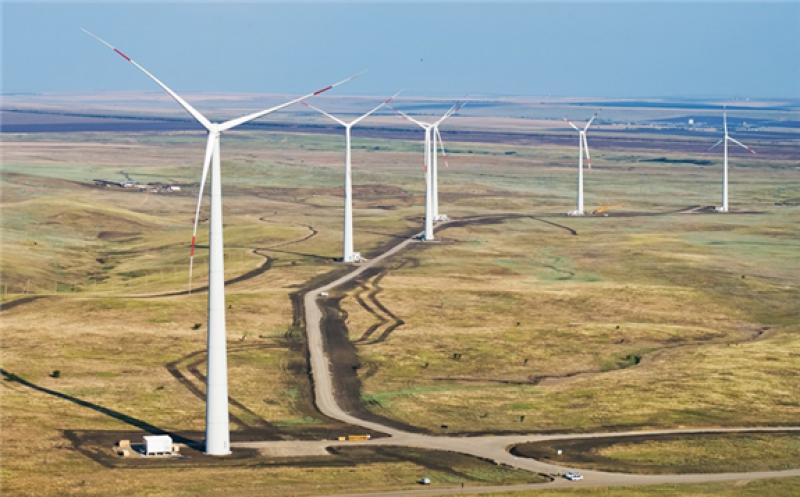
In total, the contract between Elemash Magnit LLC (an enterprise of TVEL Fuel Company of Rosatom in Elektrostal, Moscow region) and Red Wind B.V. (a joint venture of NovaWind JSC and the Dutch company Lagerwey) foresees manufacturing and supply over 200 sets of magnets. One set is designed to produce one power generator.
“The project includes gradual localization of magnets manufacturing in Russia, decreasing dependence on imports. We consider production of magnets as a promising sector for TVEL’s metallurgical business development. In this regard, our company does have the relevant research and technological expertise for creation of Russia’s first large-scale full cycle production of permanent rare-earth magnets,” commented Natalia Nikipelova, President of TVEL JSC.
“NovaWind, as the nuclear industry integrator for wind power projects, not only made-up an efficient supply chain, but also contributed to the development of inter-divisional cooperation and new expertise of Rosatom enterprises. TVEL has mastered a unique technology for the production of magnets for wind turbine generators. These technologies will be undoubtedly in demand in other areas as well,” noted Alexander Korchagin, Director General of NovaWind JSC.
For reference:
TVEL Fuel Company of Rosatom incorporates enterprises for the fabrication of nuclear fuel, conversion and enrichment of uranium, production of gas centrifuges, as well as research and design organizations. It is the only supplier of nuclear fuel for Russian nuclear power plants. TVEL Fuel Company of Rosatom provides nuclear fuel for 73 power reactors in 13 countries worldwide, research reactors in eight countries, as well as transport reactors of the Russian nuclear fleet. Every sixth power reactor in the world operates on fuel manufactured by TVEL. www.tvel.ru
NovaWind JSC is a division of Rosatom; its primary objective is to consolidate the State Corporation's efforts in advanced segments and technological platforms of the electric power sector. The company was founded in 2017. NovaWind consolidates all of the Rosatom’s wind energy assets – from design and construction to power engineering and operation of wind farms.
Overall, by 2023, enterprises operating under the management of NovaWind JSC, will install 1 GW of wind farms. http://novawind.ru
Elemash Magnit LLC is a subsidiary of Kovrov Mechanical Plant (an enterprise of the TVEL Fuel Company of Rosatom) and its main supplier of magnets for production of gas centrifuges. The company also produces magnets for other industries, in particular, for the automotive
industry. The production facilities of Elemash Magnit LLC are located in the city of Elektrostal, Moscow Region, at the site of Elemash Machine-Building Plant (a nuclear fuel fabrication facility of TVEL Fuel Company).
Rosatom is a global actor on the world’s nuclear technology market. Its leading edge stems from a number of competitive strengths, one of which is assets and competences at hand in all nuclear segments. Rosatom incorporates companies from all stages of the technological chain, such as uranium mining and enrichment, nuclear fuel fabrication, equipment manufacture and engineering, operation of nuclear power plants, and management of spent nuclear fuel and nuclear waste. Nowadays, Rosatom brings together about 350 enterprises and organizations with the workforce above 250 K. https://rosatom.ru/en/

U.S. Added Less New Wind Power in 2021 Than the Previous Year — Here’s Why
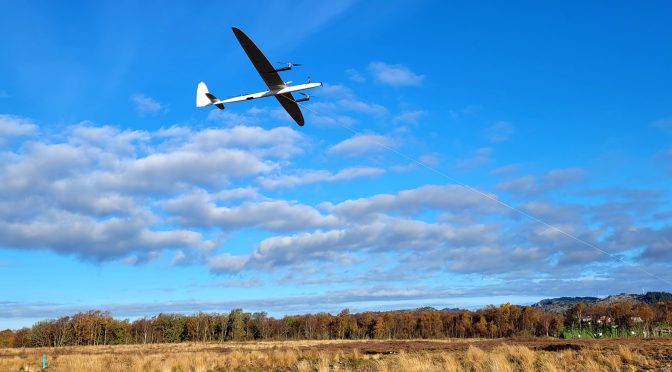
Airborne Wind Energy Developer Kitemill Prepares for 24HOUR Operation and Multi-Device Demonstrations

Vietnam's Largest Wind Power Plant Starts Operational

Vietnam Plans to Double Wind Power Generation by 2030

Developer Lines up Support for Vietnam Wind Build

Trung Nam Group Inaugurates Wind Power Plant in Vietnam

COMMENTS
Beginner Amigurumi. Welcome to The Friendly Red Fox, where you can explore easy to read crochet patterns and creative tutorials. Enjoy crochet patterns, tutorials, and resources for crochet and amigurumi enthusiasts, whether you are a beginner or a long time crocheting pro!
389. Bobble Hat. by Kali Dahle. 1 383. c2c Fox Block Blanket. by Kali Dahle. 2 905. Christmas Friends. by Kali Dahle.
It is now widely accepted that three main factors act in concert to determine the size and shape of the home range of a fox: food abundance; food dispersion; and location of shelters in relation to the main food patches. As a consequence, home range size varies widely: from about four hectares (ha)—almost 10 acres—in some urban areas, to ...
Crochet Patterns. Mountain Ridges Hat. Fox Hat. C2C Fox Blanket. Seamless Granny Square. Mountain Ridges Scarf. Amigurumi Patterns, perfect for beginners. Crochet animals, dolls, and things in between! 0ver 10,000 Five Star ratings.
Crochet tutorials and follow along patterns for patterns from The Friendly Red Fox. Visit my blog at www.thefriendlyredfox.com!
patterns > The Friendly Red Fox. The Friendly Red Fox Source; Viewing as a guest user. What am I missing? overview. patterns (64) projects. discussions. editors. patterns (64) ... overview. patterns (64) projects. discussions. editors ••• The Friendly Red Fox. thefriendlyredfox.com. Website Notes. Website thefriendlyredfox.com. errata 1 2 ...
Check out our friendly red fox patterns selection for the very best in unique or custom, handmade pieces from our patterns shops.
June said. September 4, 2009 @. Thank you all! Jana, I just measured and my super-sized Arctic Fox is about 10″ nose to bum - he'd be about 18″ nose to tail if posed like the Red Fox. The hook, yarn and eye sizes I used are included in the pattern if you want to make an exact duplicate, but Patons Divine is fuzzy to begin with and so ...
The Crochet Fox Hat looks a little bit like knitting, but this Easy Fox Hat is made with single crochet stitches in the back loops. The pattern is straightforward, so it's perfect for a bit of crochet multitasking with your latest favorite TV show or podcast. Designer: Winding Road Crochet.
Buy Material Kit. <p>Dave Whitlock developed this fly back in the late 1960s and considers it one of his best nymph patterns. It's a big-bodied nymph and Dave uses a blend of Red Fox Squirrel fur and a synthetic sparkle material for the dubbing giving it a unique reddish-brown appearance. The fly is typically tied in sizes 10-18.</p>.
Gather your craft tools and materials. Then download the fox pattern on the right hand side at the top of this post. Cut out felt according to pattern using a Cricut Maker (optional) or scissors. Sew the legs to the underside piece using two strands of white embroidery floss and a whip stitch, working from what will be the inside of the legs.
This written crochet pattern includes all the instructions needed to make your own 4-way jointed fox with moving arms and legs. Includes one PDF file, 17 pages. Pattern is written in English, using US crochet terminology. I included detailed instructions, many step-by-step photos and useful tips and tricks. SIZE
This is the Red Fox Squirrel Nymph, one of his more well-known patterns. It's elegant, versatile, effective and rather easy to tie. In other words, a near perfect fly. The Red Fox Squirrel Nymph starts with a 2X long nymph hook, here a Fulling Mill 5085 in size 14. Begin by getting the hook firmly secured in the jaws of your tying vise.
The Friendly Red Fox / Free Patterns - Page 6. Free Patterns. Free Patterns | Holiday Amigurumi. Crochet Santa Hat Jar Topper ... and cuddly. I focus on providing fun to follow patterns and comprehensive tutorials so you can enjoy the creative process! From adorable amigurumi to colorful blankets, whether you are a beginner or long-time ...
Today's total solar eclipse is the first widespread one in the Lower 48 states since 2017 and the last one until 2044. W e're here to help track the weather with a series of maps below, including ...
Welcome to the 628DirtRooster website where you can find video links to Randy McCaffrey's (AKA DirtRooster) YouTube videos, community support and other resources for the Hobby Beekeepers and the official 628DirtRooster online store where you can find 628DirtRooster hats and shirts, local Mississippi honey and whole lot more!
Heavy rain that brought a widespread 0.75-1.50″ of rain on Friday, even up to 2″ in parts of Worcester County, is moving out ahead of Saturday. Drier weather will set in as we continue into the morning and some may even see the sunrise! Breaks in the clouds will quickly fill in once again ...
Red Fox crochet pattern. This measures about 9cm tall and 21cm in length, when made with double knit yarn or about 11cm tall and 28cm in length, when made with aran yarn. When I make this Red Fox I use the Copper and Cream shades of Stylecraft yarn, but any two that go well together would work. Materials: For the smaller size animal:
The Friendly Red Fox. This is the rounds 9 and 10 of the no sew crochet turtle pattern.
These patterns also reflect CuteGirl's Keltic heritage. And as a last reference to the smithing, I decided to add not a motto or supporters, but a beautifully smithed frame (or console). How the prompt fits in: When thinking of ornamental knots, the first thing that comes to my mind are the Keltic knots.
Created by Ray Smith, the Dean of Esopus Creek sometime in the mid-20th century, the Red Fox is a fairly typical Catskill style dry fly.Hook: #12-16 dry flyT...
This pattern is available for $3.50 USD buy it now. True to the nature of a fox, this pattern eluded me for a long time. I'm excited to say he's now ready to join my bundle of woodland animals and scamper into your arms! Details. Red Fox is 8 inches tall and gracefully seated on his hind legs. He is worked in one piece from head to tail ...
Travel Education Business History Science & Tech Russian Kitchen Christmas gift guide to Moscow surroundings. Travel Dec 12 2013 ...
This free crochet axolotl pattern is cute and quick to make! Using blanket yarn makes this a cuddle sized amigurumi axolotl plushie, while using worsted weight yarn makes a 5 inch little backpack buddy! ... The Friendly Red Fox / Amigurumi / Free Crochet Axolotl Pattern. Amigurumi | Amigurumi Animals | Free Patterns. Free Crochet Axolotl ...
In total, the contract between Elemash Magnit LLC (an enterprise of TVEL Fuel Company of Rosatom in Elektrostal, Moscow region) and Red Wind B.V. (a joint venture of NovaWind JSC and the Dutch company Lagerwey) foresees manufacturing and supply over 200 sets of magnets. One set is designed to produce one power generator.